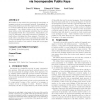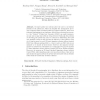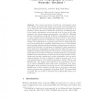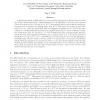EUROCRYPT
2001
Springer
14 years 4 months ago
2001
Springer
In STOC 2000, Canetti, Goldreich, Goldwasser, and Micali put forward the strongest notion of zero-knowledge to date, resettable zero-knowledge (RZK) and implemented it in constant ...
CCS
2001
ACM
14 years 4 months ago
2001
ACM
Authenticating mobile computing users can require a significant amount of processing and communications resources— particularly when protocols based on public key encryption are...
ASIACRYPT
2001
Springer
14 years 4 months ago
2001
Springer
The Advanced Encryption Standard (AES) provides three levels of security: 128, 192, and 256 bits. Given a desired level of security for the AES, this paper discusses matching publi...
ACISP
2001
Springer
14 years 4 months ago
2001
Springer
Abstract. At ACISP 2000, Yoo et al proposed a fast public key cryptosystem using matrices over a ring. The authors claim that the security of their system is based on the RSA probl...
COCOON
2010
Springer
14 years 4 months ago
2010
Springer
In identity-based public-key cryptography, an entity’s public key can be easily derived from its identity. The direct derivation of public keys in identity-based public-key crypt...
CCS
2003
ACM
14 years 4 months ago
2003
ACM
We describe a new method for protecting the anonymity of message receivers in an untrusted network. Surprisingly, existing methods fail to provide the required level of anonymity ...
INDOCRYPT
2004
Springer
14 years 4 months ago
2004
Springer
ID-based public key systems allow the user to use his/her identity as the public key, which can simplify key management procedure compared with CA-based public key systems. However...
EUROCRYPT
2004
Springer
14 years 4 months ago
2004
Springer
We study the problem of searching on data that is encrypted using a public key system. Consider user Bob who sends email to user Alice encrypted under Alice’s public key. An ema...
ESAS
2004
Springer
14 years 4 months ago
2004
Springer
The common perception of public key cryptography is that it is complex, slow and power hungry, and as such not at all suitable for use in ultra-low power environments like wireless...
PKC
2005
Springer
14 years 5 months ago
2005
Springer
A well-known attack on RSA with low secret-exponent d was given by Wiener about 15 years ago. Wiener showed that using continued fractions, one can efficiently recover the secret-...




